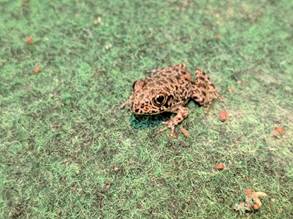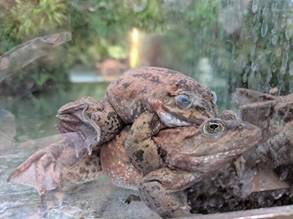
TORONTO ZOO IS MAKING THE LEAP TO SAVE FROGS WITH COLLABORATIVE REPRODUCTIVE RESEARCH


Dusky gopher froglet (left) and adult Oregon spotted frogs (right). Photo Credit: Toronto Zoo
TORONTO, ON, Tuesday, May 1, 2018: Toronto Zoo is proud to be the home of some of the most critically endangered amphibians in North America. The habitat of many of these species has been so drastically changed by humans that they now only live in small isolated populations, some having an estimated wild population of just 100 frogs. With the support of many partners, zoos across North America have initiated conservation breeding programs for several of the most threatened species in the hopes of releasing them back to restored habitats in the wild.
For several years the Toronto Zoo has participated in Species Survival Plan (SSP) breeding programs for both the critically endangered dusky gopher frog (Lithobates sevosus), also commonly known as the Mississippi gopher frog, and the Endangered Oregon spotted frog (Rana pretiosa), two North American species that are notoriously difficult to breed outside of their natural habitat. In the wild, the frogs go through a winter hibernation period until the spring rain and rising temperatures signal them to awaken and start breeding. At the Toronto Zoo, we endeavor to mimic the specific environmental cues required to encourage natural breeding, but the Zoo’s initial attempts were met with limited reproductive success.
In the fall of 2017, the Zoo’s Amphibian and Reptile Curatorial staff and Reproductive Physiology team worked together to overcome the challenges of natural breeding in the dusky gopher frog by applying Assisted Reproductive Technologies (ART). Using techniques originally developed by amphibian researcher, Dr. Andy Kouba, Mississippi State University, a subset of adult frogs underwent a series of hormone injections prior to the collection of eggs or sperm that were combined together in a petri dish for in vitro fertilization. Within hours the team witnessed the first dusky gopher frog embryos ever to develop in Canada. Over the next several months Zoo staff watched the embryos metamorphose into tadpoles, and finally juvenile frogs, which will ultimately be released into the wilds of southern Mississippi in summer 2018.
“Our ability to work with these highly endangered amphibians in a protected zoo environment is essential to their survival,” says Dr. Andrew Lentini, Curator of Amphibians and Reptiles, Toronto Zoo. “We are proud of our contribution to their recovery in the wild.”
“This achievement highlights the valuable role that assisted reproductive technologies can have in enhancing breeding outcomes for diverse threatened species,” says Dr. Gabriela Mastromonaco, Curator of Reproductive Programs and Research, Toronto Zoo.
Given the success of our first frog ART trial, the Zoo applied the same technique used with the dusky gopher frogs to a group of Oregon spotted frogs this past spring. Within days we were once again excited to see developing tadpoles; the first report of successful ART in Oregon spotted frogs.
Due to the sensitive nature of the dusky gopher and Oregon spotted frogs, their habitats are located in a quarantined area of the Zoo and not on public display.
-30-
Toronto Zoo Media Contacts:
Katie Gray, Supervisor of Public Relations and Events
[email protected] or #416-392-5941
Amanda Chambers, Public Relations and Events Associate
[email protected] or #416-392-5974
About The Toronto Zoo
The Toronto Zoo is Canada’s premier zoo and a national leader in saving wildlife to ensure the rich diversity of nature for future generations. More than a tourist attraction, the Toronto Zoo boasts a number of leading programs for helping wildlife and their natural habitats – from species reintroduction to reproductive research. A world-class educational centre for people of all ages, the Toronto Zoo is open every day except December 25 and attracts approximately 1.3 million visitors each year.
